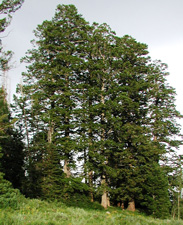Resource Library
Plant of the Week: Fir, Douglas
The University of Arkansas System Division of Agriculture does not promote, support or recommend plants featured in "Plant of the Week." Please consult your local Extension office for plants suitable for your region.
Plant of the Week
Douglas Fir
Latin: Pseudotsuga menziesii

Traveling to the mountainous west is always a delight for a plant lover for it is where the really big trees grow. As we drive along, the identity of these forest giants often remains a mystery for those of us raised in the eastern woodlands. Their shapely silhouettes just don't match up with anything in our mental database. One I am beginning to identify on sight is the tall, straight pyramidal form of the Douglas fir, Pseudotsuga menziesii.
Douglas fir is a big tree, routinely reaching heights of 100 to 120 feet with a long, straight trunk often 3 to 4 feet across. On the Olympic Peninsula of Washington State, I once ran across a Douglas fir with a trunk about 8 feet across, though most of these forest giants are now gone.
In Vancouver's Stanley Park a number of old stumps of similar dimension are found, not yet rotted away after they fell over a century ago. The park is a second growth forest with the now-enormous trees 3 feet in diameter after a century of protection. These forest giants routinely reach 600 to 800 years of age.
Douglas firs have a tall, slender pyramidal form, growing as a perfect Christmas tree while young. In crowded forest situations, they tend to drop their lower limbs but in more open areas retain their branches which may have a spread of 20 feet across. Old trees develop a thick gray-brown bark that protects the trunks from fire.
The inch-long green or bluish needles are small and arranged along the twigs in bottlebrush fashion. The cones are 3 to 4 inches long, egg-shaped with prominent three-pronged bracts that separate them from most other western conifers. Though they bear the common name “fir,” they are not a true fir.
We meet up with Douglas fir on a daily basis for it is one of the most common timber trees in the west. It is used extensively for dimension lumber, plywood and other construction applications. The white wood is light in weight, relatively strong and, depending on the grade, free of knots.
In its native range it extends from the southern Rocky Mountains of New Mexico to the Gulf of Alaska. It reaches its largest size in high rainfall areas along the Pacific coast but is relatively drought tolerant and is found at higher elevations in interior locations receiving 20 to 30 inches of precipitation a year.
Douglas fir is named for David Douglas, the plant explorer the Royal Horticulture Society sent to the western United States in the 1820s and 30s. He explored the Pacific Northwest for much of a decade, collecting many botanical firsts, including this species and most of the other forest giants of the region. On his return to England in 1834, he decided to stop off at the Sandwich Islands - what we today know as Hawaii. Unfortunately, while there he impaled himself on sharpened poles placed at the bottom of a disguised pit dug to capture wild cattle.
Douglas fir will grow in the eastern United States but it is not common. Some Christmas tree farmers plant it, and it is common as a cut tree during the Yuletide season. Trees I planted reached 20 feet in 10 years. Plant it in a well drained soil in full sun. Once established it has good drought tolerance. Bagworms can be a problem.
By: Gerald Klingaman, retired
Extension Horticulturist - Ornamentals
Extension News - August 10, 2007
The University of Arkansas System Division of Agriculture does not maintain lists of retail outlets where these plants can be purchased. Please check your local nursery or other retail outlets to ask about the availability of these plants for your growing area.